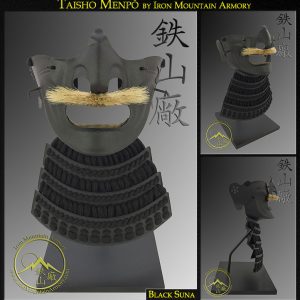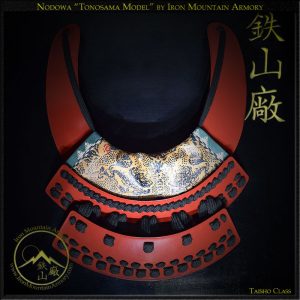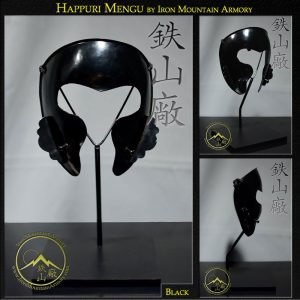- Traditionally Handcrafted
- Customizable
- Shipped Direct From The Armory
- Best Price Guarantee
- World wide delivery
Tengu Menpo (face armor) is a Gashira Class reproduction of an original menpo, which features a tengu (bird like) nose as well as (facial wrinkles) , odayori ore kugi (posts), hana (detachable nose guard), mimi (ear covers)and tare (throat guard). The Tengu were believed to be malevolent human-like avian creatures or deities from the high mountain tops of Japan. Spoke about by the Shugendo sect of monks, the Tengu caught the imagination of samurai who wanted to replicate their mystical image in their armor to gain favor and possibly even their blessing and in turn receive supernatural powers, or simply strike fear into any enemy that faces them. Either way, they make for a great looking and very unique menpo.
History: The menpo was traditionally used not only to protect the face in battle, but to help hold the cords of the kabuto (helmet) to the warrior’s head, while providing protection from the shinobi-no-o (kabuto rope). The shinobi–no-o would tie around the ore kugi (L shaped post), located on the menpo cheeks and then down under the chin. The menpo could have a cord, which tied over the crown of the warriors head, and/or could be tied to the shinobi-no-o, to be secured to the samurai warrior’s face.
Our menpo, like all of our armor, are full sized and functional. It can fit your existing kabuto, or looks great displayed by itself with one of our Menpo Display Stands, worn for decoration, at a re-enactment or as part of a costume.
Features: Gashira Class Tengu Menpo
[table id=236 /] (Back Ordered Until February 2021).
[table id=PF /]
References: “The Samurai Armour Glossary” by Ian Bottomley & David Thatcher / “The Watanabe Art Museum Samurai Armour Collection Volume 1: Kabuto & Mengu” By Trevor Absolon



